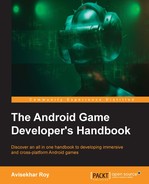- The Android Game Developer's Handbook
- Table of Contents
- The Android Game Developer's Handbook
- Credits
- About the Author
- About the Reviewer
- www.PacktPub.com
- Preface
- 1. Android Game Development
- 2. Introduction to Different Android Platforms
- Exploring Android mobiles
- Exploring Android tablets
- Exploring Android televisions and STBs
- Exploring Android consoles
- Exploring Android watches
- Development insights on Android mobiles
- Development insights on Android tablets
- Development insights on Android TV and STBs
- Development insights on Android consoles
- Development insights on Android watches
- Platform-specific specialties
- Summary
- 3. Different Android Development Tools
- 4. Android Development Style and Standards in the Industry
- 5. Understanding the Game Loop and Frame Rate
- 6. Improving Performance of 2D/3D Games
- 2D game development constraints
- 3D game development constraints
- The rendering pipeline in Android
- Optimizing 2D assets
- Optimizing 3D assets
- Common game development mistakes
- 2D/3D performance comparison
- Summary
- 7. Working with Shaders
- 8. Performance and Memory Optimization
- Fields of optimization in Android games
- Resource optimization
- Design optimization
- Memory optimization
- Don't create unnecessary objects during runtime
- Use primitive data types as far as possible
- Don't use unmanaged static objects
- Don't create unnecessary classes or interfaces
- Use the minimum possible abstraction
- Keep a check on services
- Optimize bitmaps
- Release unnecessary memory blocks
- Use external tools such as zipalign and ProGuard
- Performance optimization
- Relationship between performance and memory management
- Memory management in Android
- Processing segments in Android
- Different memory segments
- Importance of memory optimization
- Optimizing overall performance
- Increasing the frame rate
- Importance of performance optimization
- Common optimization mistakes
- Best optimization practices
- Summary
- Fields of optimization in Android games
- 9. Testing Code and Debugging
- 10. Scope for Android in VR Games
- Understanding VR
- VR in Android games
- Future of Android in VR
- Game development for VR devices
- Introduction to the Cardboard SDK
- Basic guide to develop games with the Cardboard SDK
- VR game development through Google VR
- Android VR development best practices
- Challenges with the Android VR game market
- Expanded VR gaming concepts and development
- Summary
- 11. Android Game Development Using C++ and OpenGL
- 12. Polishing Android Games
- 13. Third-Party Integration, Monetization, and Services
- Google Play Services
- Multiplayer implementation
- Analytic tools
- Android in-app purchase integration
- Android in-game advertisements
- Monetization techniques
- Planning game revenue
- User acquisition techniques
- User retention techniques
- Featuring Android games
- Publishing Android games
- Summary
- Index
The scope of 3D games is increasing day by day with more quality and performance. However, this requires hardware support for the running Android platform. Old devices are not obsolete yet.
It becomes a serious problem when the same application runs on various devices. This becomes a challenge for developers to run the same application across devices.
There are many technical differences between 2D and 3D games in terms of rendering, processing, and assets. The developer should always use an optimized approach to create assets and write code. One more way of gaining performance is to port the games for different hardware systems for both 2D and 3D games.
We can see a revolutionary upgrade in hardware platforms since the last decade. Accordingly, the nature of games has also changed. However, the scope of 2D games is still there with a large set of possibilities.
There are many frameworks and engines available for developing 2D and 3D games. Support for multiple operating systems has also increased its value for both 2D and 3D games.
Improving performance is more of a logical task than a technical one. There are a few tools available to do the job, but it is the developer's decision to choose them. So, selecting the right tool for the right purpose is necessary, and there should be a different approach to making 2D and 3D games.
We have already discussed the rendering processes in both 2D and 3D development. We will further enhance rendering with the help of shaders in Android and try to explore various techniques of optimizing Android games later in this book.
-
No Comment
